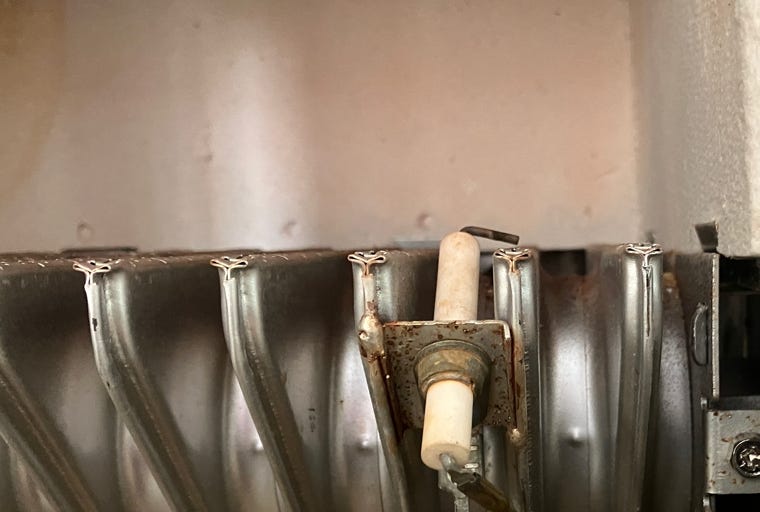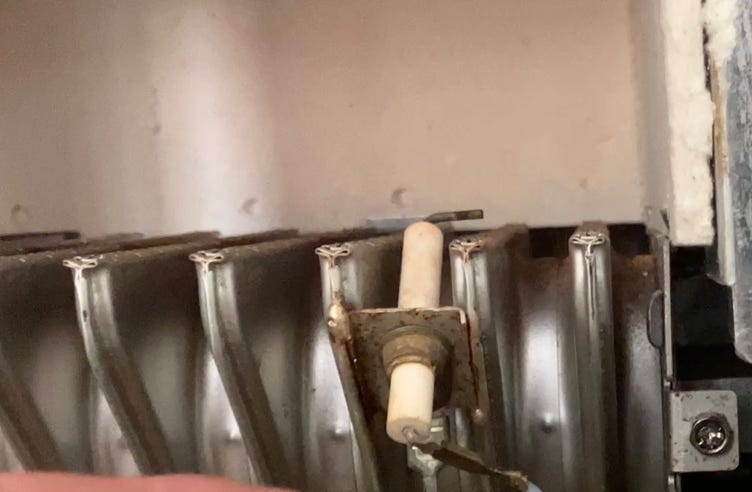
Mike the Boilerman
Your independent Potterton Suprima repair specialist based near Hungerford, Berkshire. Call or text me on 07866 766364

Mike the Boilerman
Your independent Potterton Suprima repair specialist based near Hungerford, Berkshire. Call or text me on 07866 766364
The Suprima L is difficult to distinguish from the Suprima Original other than by reading the data plate. It looks identical and works in the same general way. The main difference is that the Suprima Original is ‘range rated’, (meaning that the output of each boiler can be adjusted by changing the gas pressure to the burners), while each model of Suprima ‘L’ has a fixed output and may not be changed. The high output 120 size has now been introduced to the ‘L’ range too.
Apart from the minor differences above the ‘L’ model is effectively identical to the Suprima Original, has all the same features and suffers the same common failures, so if you notice this list is the same as for the Suprima Original, you’d be right!
One significant difference to the technician between the Suprima L and the original non-L, is the introduction of a flow switch in around 2004. On models without the flow switch, if the circulating pump failed then the boiler would overheat and boil furiously for a while before the overheat protection thermostat tripped and turned the boiler OFF. On L models with a flow switch, the boiler is prevented from firing in the first place by the flow switch in the event of pump failure.
Here are the common problems with the Suprima L, in order of likelihood:
1) Control board failure
This only applies to the early version control boards. (Not many of these left now, most have been upgraded to the new version made by Siemens.) You get a solid red light showing on the front panel and the re-set button needs to be pressed. Although the manual says this means the boiler overheated, it usually didn't and the control board is beginning to fail. The boiler will work again for a random length of time then lock out again with the same solid red light symptom, and the button will need pressing again. This was such a common problem (and Potterton denied it) that this boiler featured on BBC "Watchdog" programmes and eventually Potterton redesigned and marketed an completely different control board. Most Suprimas have now had this new control board fitted. The 'red light' problem is not so common these days and only occurs of Suprimas with the old style control board.
The new Siemens control board is also perfectly capable of failure but in different ways to above. I’ve encountered Siemens boards which behave randomly then work correctly for a while after pressing the re-set button. This correct operation of the boiler after re-setting tends to be temporary and if further re-sets are required, another new Siemens board will be needed. The second way in which the Siemens board can fail is the boiler will heat to a random and different temperature each time it lights. Users with conventional central heating systems often don’t notice this at all but when a boiler with this fault is connected to a thermal store e.g. a Gledhill Boilermate 2000, the result will present as random, intermittent and unexplained central heating failure. The cause being the store randomly being heated to the adequate temp for the thermal store control board to permit heating to come on, or not, depending on each cycle temperature reached by the Suprima.
I’ve also come to notice the Siemens board light the burners, but fail to keep them alight for more than a few seconds. It turns the burners off after perhaps 30 seconds then re-lights the boiler without stopping the fan and going through the whole ignition sequence from scratch. This is occasionally a failing thermistor but more often the control board needs replacing.
2) Flow sensor/air pressure switch error
There is a water flow switch fitted to the outlet pipe from the heat exchanger in later versions of the Suprima L connected in series with the air pressure switch. This flow switch senses the presence of water flow, so before the boiler will light there needs to be both water flow detected and flue fan air pressure detected by the air pressure switch. If either signal is missing then the PCB will give a red light flashing three times per second which the manual says is fan failure - most confusing. If fault-tracing reveals the flow sensor is actually open circuit, it is easy to jump to the conclusion the flow sensor has failed but in my experience it is usually correctly detecting the absence of water flow. Circulating pump failure, motorised valve failure, blocked pipes might all be the root cause of this supposed ‘fan failure’ error reported by the PCB. Furthermore, the pipe nuts connecting the flow switch are factory tightened to such a degree they cannot be loosened by a repair technician even with really good side access, so replacing a genuinely failed flow sensor can involve cutting of the nuts with a grinder, or even removal of the whole flow pipe from the boiler and the flow switch replaced on the bench.
3) Flue Fan Failure
As with most fanned-draught boilers, flue fan wears out and fails occasionally. Combustion gas is blown out of the boiler with an electric fan - a safety-critical component. If the fan fails to start, the safety device which tests to see if the fan is running before allowing the boiler to light. To the user the boiler will stay silent (or possibly hum quietly) instead of bursting into life as normal when a demand for heat is turned on, and the ‘three red flashes per second’ error displayed. The fan is still freely available as a spare part and is fairly straightforward to install.
3) Air Pressure Switch failure
The safety device which tests the fan for correct operation is the air pressure switch. These are known to fail occasionally and the result is the fan runs, the boiler sounds for all the world as though it is about to light, but no ignition occurs and the ‘three red flashes per second’ error is displayed. A new air pressure switch is usually required.
4) Solenoid gas valve failure.
The symptoms appear to be the same as air pressure switch failure above (i.e. the fan runs, the boiler seems about to light but never does). The difference is that air pressure switch has detected the fan and power is being sent to the gas control valve, but the progression to lighting the main burner never happens. The solenoid in the gas valve has usually failed and a new gas valve is needed.
5) Thermistor failure
The thermistor is a semiconductor device that senses the temperature of the flow pipe from the heat exchanger so the control board can turn the gas flames on and off to maintain a broadly steady flow temperature. The resistance of the thermistor rises and falls with temperature and the control board reads this resistance and uses the information to work out when to turn the gas flames on and off. Its quite common for the thermistor to stop changing resistance linearly which confuses the control board, leading the the gas flames turning OFF at too low a temperature. The boiler still lights and runs briefly but turns OFF at too low a temperature. Quite perplexing to the user!
6) Ignition electrode failure.
The electrode is a rod of hardened steel inside a ceramic tube/holder. At the sparking end, the rod is bent over at 90 degrees and should be 4mm away from the gas burner bar. The spark jumps from the electrode to the burner bar to ignite the gas flame. If the metal rod loosens inside the outer ceramic tube, the steel rod can rotate a little which will reduce the spark gap or even touch the burner bar, reducing the spark size and its ability to light the gas. The fault presents as random locking out in much the same way as when the control board fails. Fitting a new electrode is quick and easy.
For more information or a repair to your Suprima, call or text me on my mobile 07866 766364

Suprima ignition electrode photos showing faulty electrode with almost zero spark gap (above), and electrode in good condition with correct spark gap (below).

If my pages have been helpful and you’d like to buy me a coffee, click here. Thank you kindly!
Copyright Michael Bryant 2024
Site first created 12th November 2014
Last updated 17th April 2024
Gas Safe Register 197499. CIPHE reg no 56207